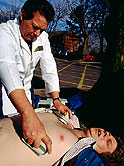
FRIDAY, Sept. 10 (HealthDay News) — Patients who experience sudden cardiac arrest outside of a hospital setting fare just as well when treated with chest compressions before being treated with an electrical defibrillator as they do when getting immediate defibrillation, new research indicates.
In fact, immediate chest compression treatment may actually improve a patient’s chance of survival, given the critical time that can elapse while waiting for an emergency medical services (EMS) response team to get to the scene with appropriate defibrillator equipment, the study authors found.
“The compressions-first approach appears to be as good as the defibrillation-first approach, especially if there are delays to EMS arriving on-scene,” senior study author Dr. Comilla Sasson, an emergency medicine physician researcher at the University of Colorado, said in a news release from the University of Michigan. “This has major policy implications.”
Sasson (who worked on the study while at the University of Michigan) and lead author Dr. Pascal Meier, of the University of Michigan’s Cardiovascular Center, reported their findings in the Sept. 9 online edition of the journal BMC Medicine.
The study authors pointed out that most people who experience cardiac arrest outside of a hospital do not survive the event, regardless of treatment.
As distinguished from a heart attack, sudden cardiac arrest is the total, abrupt and unexpected loss of heart function. It can strike people who have no known history of heart disease and typically occurs very quickly after the onset of symptoms.
While about 300,000 cardiac arrest patients are cared for by EMS workers each year in the United States, only about 8 percent of those treated outside a hospital setting survive, the authors noted.
Nevertheless, in a search for the best possible treatment scenario, the researchers analyzed data concerning about 1,500 cardiac arrest patients who had participated in one of four prior trials.
Current national guidelines (in place since 2005) advocate the immediate defibrillation option for patients not already in a hospital when a cardiac arrest strikes. The equipment is used to electrically shock the heart to try to revive its normal rhythm.
In an effort to compare the effectiveness of this approach with that of chest compressions, the team stacked up survival rates among their patient pool following the chest compression-first option (for a minimum of 90 seconds) versus defibrillation-first.
“It appears that both treatments are equivalent,” Meier noted in the news release.
In fact, one-year survival was actually higher among those patients who had initially received compression treatment, the authors noted.
The team went on to conclude that the chest compression-first approach might even be preferable to defibrillation-first in those instances where EMS faces a five-minute or longer response time.
“Our study shows that chest compressions matter, so even more emphasis should be placed on doing high-quality chest compressions both by laypeople providing bystander CPR and EMS providers,” said Sasson.
“Based on our study, current guidelines emphasizing early defibrillation still are important,” said Meier.
“However, since the outcomes with the chest compression-first approach were not inferior and might be even better in the long term, and in case of longer response times, this study may have an impact on future guidelines.”
The American Heart Association is expected to announce its 2010 emergency cardiovascular care guidelines within the next few weeks.
In the meantime, Dr. Thomas Rea, medical director of the Emergency Medical Services Division of Public Health for Seattle and King County in Washington, said that the question of how to prioritize treatments when all options are available is “tricky.” However, he strongly seconded the notion that chest compression treatment is of enormous benefit in certain situations.
“Certainly it’s straightforward and reasonable to say that in lieu of having a defibrillator — if one is not available right away — certainly the best course of action in addition to activating the 911 system is to immediately commence with chest compression,” he said.
“In fact, that is paramount,” Rea continued. “It really saves lives. And as part of CPR, it doubles the chances of survival early on.”
Rea explained that the procedure involves putting the heel of one’s hand on the chest, locking the wrist, and compressing down a couple of inches repeatedly in a pumping action.
“So it’s a really simple basic skill that is easy to master, and can be learned in minutes. And people who are nervous about it should know that you are not going to hurt that patient. Their straits are already dire. You are only going to help when you take action,” Rea added.
More information
For more on sudden cardiac arrest, visit the American Heart Association.

